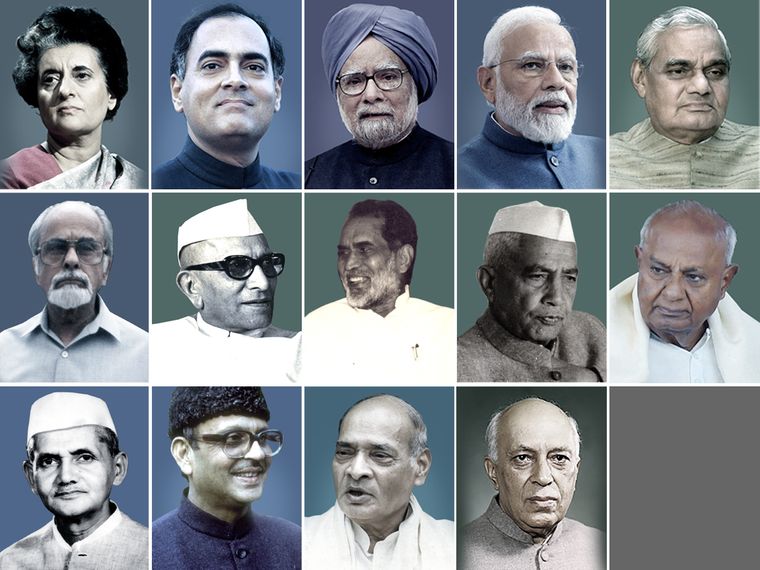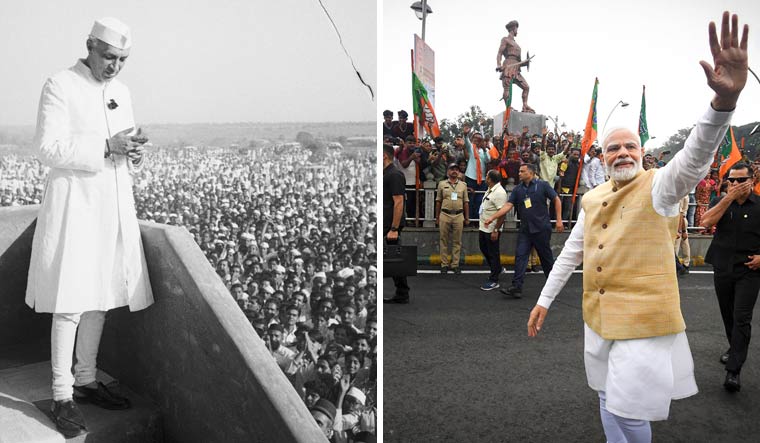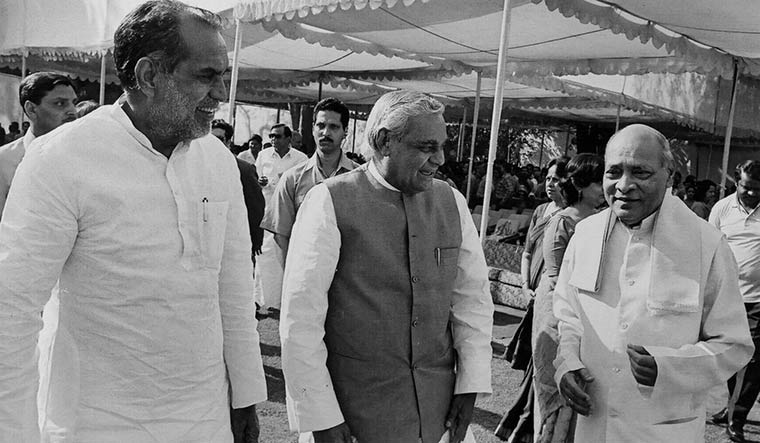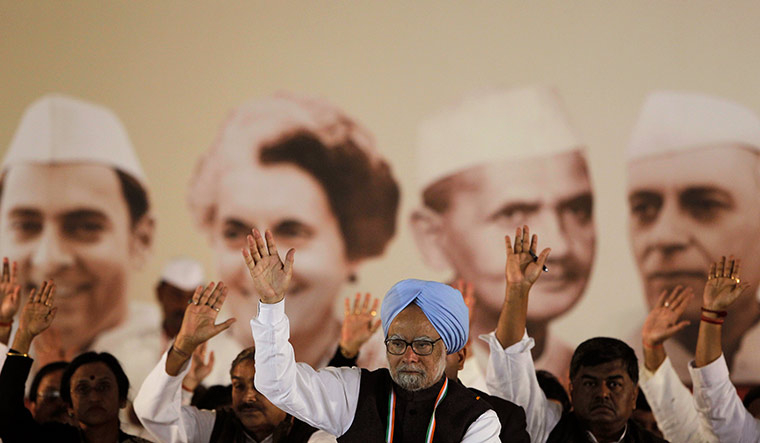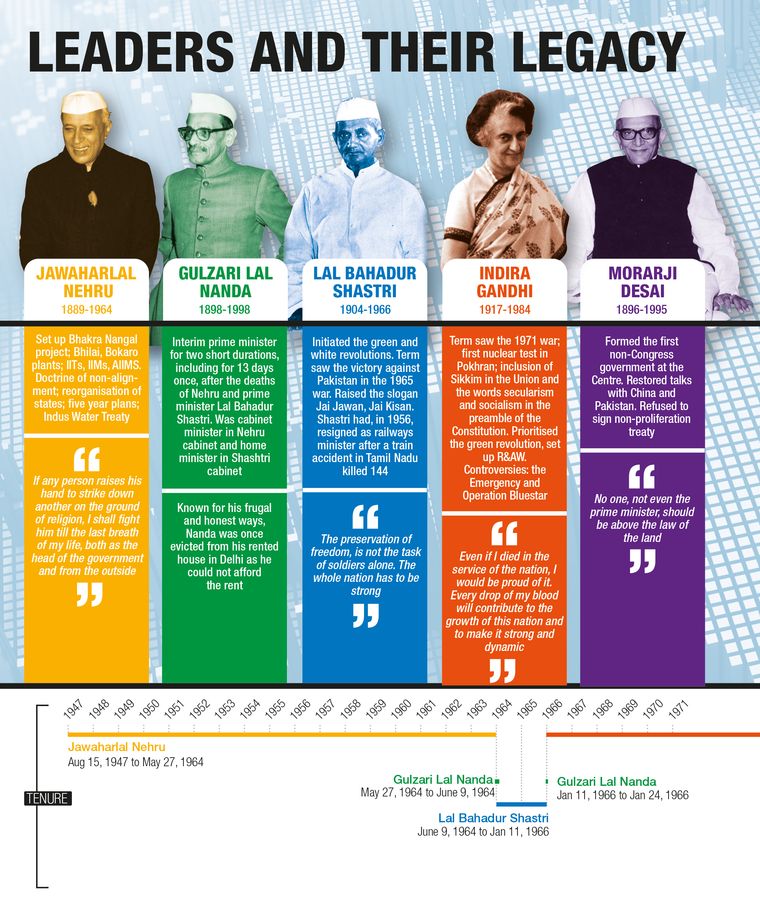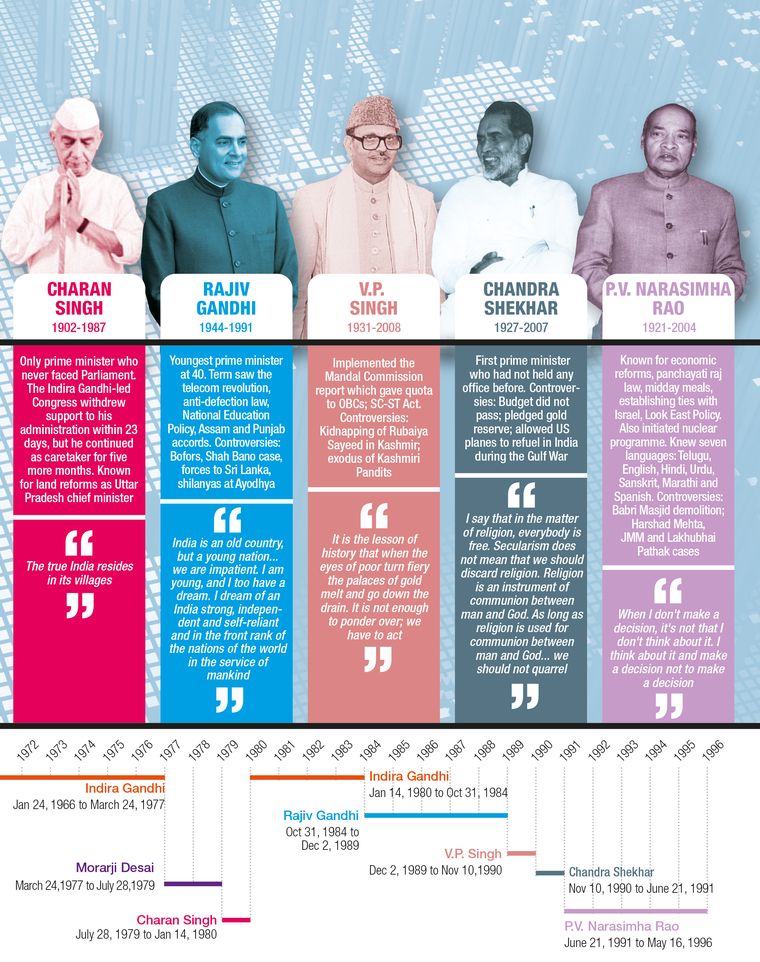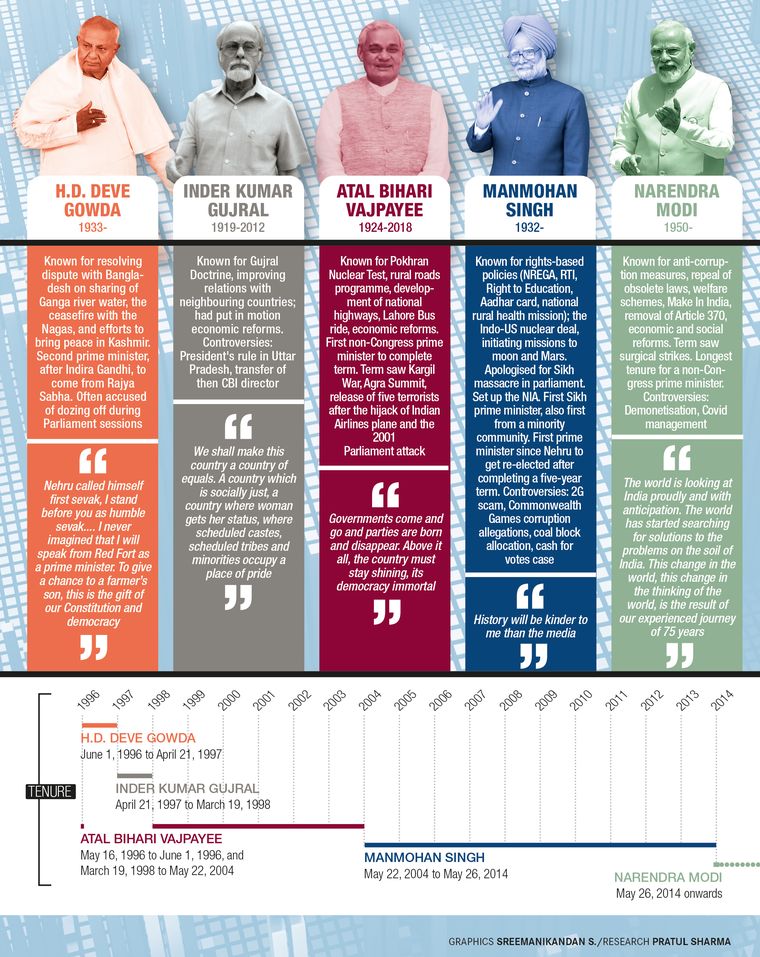If British authority is injured or destroyed, the whole efficiency of the services... upon which the Indian masses depend for their culture and progress will perish with it. India will fall back quite rapidly through the centuries into the barbarism and privations of the Middle Ages.
Winston Churchill, March 18, 1931
In its 75 years as an independent nation, India has meandered through chaos, weathered violent assaults on its unity, witnessed social and religious upheavals, yet it did not perish as its colonial masters once thought. The ‘Idea of India’ has undergone changes, as imagined by its leaders, particularly, the prime ministers, still there has also been a continuity.
Prime Minister Narendra Modi’s ‘New India’ is ideologically different from the vision articulated by the nation’s first prime minister, Jawaharlal Nehru. A dozen other prime ministers who served between them enriched the debate. The political evolution of India is also the story of its prime ministers, their contributions and ideas. Some may have been far more impactful than others. The prime ministers have drawn legitimacy through their success at the ballot box. In a first-past-the-post system, the elections have often been an exercise in choosing a prime minister rather than a party. This means that successful candidates need to be charismatic and be able to directly engage with voters.
If elected again in 2024, Modi would be the only prime minister after Nehru to have won three consecutive terms. He rode to power in Delhi as an outsider with a promise of clean and strong governance. Aided by his catchy speeches, welfare schemes, financial inclusion measures, social initiatives and by projecting India’s soft power at home and abroad, Modi has cemented his position as a mass leader, channelling the energy of the nation. And he continues to win elections, notwithstanding some unpopular measures like demonetisation and lockdowns.
Modi’s tenure is marked by a strong focus on nationalism, with hindutva as its key ingredient. When the BJP first came to power under Atal Bihari Vajpayee, the party had to abandon its pet issues such as the abrogation of Article 370 and the building of Ram temple in Ayodhya “due to a lack of majority in Parliament”. But with Modi getting the party a majority of its own, the BJP was able to fulfil both wishes.
Modi has been the most assertive prime minister India has seen since the days of Indira Gandhi. With his zeal for a clean break from the past and his wish to leave a memorable legacy, he is building infrastructure across the country. In the national capital, Nehruvian structures are being brought down and old landmarks like Pragati Maidan, parliament building, central secretariat and the prime minister’s residence replaced. India’s presidency of the G20 has given Modi yet another opportunity to leave his mark on foreign policy and further exercise the nation’s heft in the global arena.
The poor have theoretically been at the centre of policy for most prime ministers―the garibi hatao (eliminate poverty) slogan was Indira’s calling card. Modi has put that theory into effective practice and it may be the most important factor behind his extraordinary political success, says economist Surjit Bhalla in the book Modi@20: Dreams Meet Delivery. “Modi has the confidence because he, unlike other prime ministers, identifies with people; he understands their trials, their poverty, and their aspirations. And that is almost a guarantee for political success.”
Modi’s integration of his religiosity with nationalism is perhaps the sharpest articulation of hindutva in 75 years, leading to the criticism that his rule is majoritarian. Modi’s idea of India differs from Nehru’s, especially in the manner they look at religion. Nehru was agnostic, yearned for better representation of minorities in all sectors, and that model was followed by subsequent Congress governments. For instance, Manmohan Singh’s suggestion that the fruits of development should be shared equitably with the minorities and the setting up of the Sachar Committee drew inspiration from that thought.
Nehru’s legacy had defined the Indian ideal for long. As he took over the reins of a wounded nation on August 15, 1947, he had the onerous task of healing it, rebuilding it and giving it a direction based on the idealism imbibed during his decades spent as freedom fighter and Congress president. “Nehru was a political leader, by force of circumstances a mass leader, who relied on workings of his mind. His making of India could not but be an intellectual project; he thus left behind a legacy of intellectual, historical and political understanding, which was grounded in empathy and religious tolerance, and deep humanity,” says historian Rudrangshu Mukherjee in his book, Nehru and Bose.
As he laid the foundation of parliamentary democracy in India, Nehru was cognisant of its likely pitfalls. Writing under a pseudonym, Chanakya, he explained the predicament, “Jawaharlal cannot become a fascist. And yet he has all makings of a dictator in him―vast popularity, energy, pride, organisational capacity, ability, hardness... love for the crowd, an intolerance for others and a certain contempt for the weak and the inefficient.” Perhaps, it was a warning to future prime ministers to beware of these signs.
Nehru’s enduring contribution has been the institutionalisation of the planning process and laying the foundation of the PMO, though cabinet was supreme then. The PMO grew in strength with subsequent prime ministers. Nehru’s foreign policy, drawn from non-alignment, too, has been followed by his successors, albeit with some modifications. Nehru differed from his mentor Mahatma Gandhi on the principles of economic development. While Gandhi rooted for a village-centric model, Nehru supported industrialisation and wanted to inculcate scientific temper in people.
Nehru was the only prime minister who was confident and broad-minded enough to include two of his biggest critics in the cabinet―Syama Prasad Mookerjee and B.R. Ambedkar. He was in power for 17 years, the longest tenure by any prime minister, before his death in office in 1964.
Nehru was followed by Lal Bahadur Shastri, the self-effacing Congress leader who relied on consensus-building. His decision to launch a new front in the western sector to counter Pakistan’s interference in Kashmir gave India a much-needed military victory in 1965, which came as a morale booster after the disastrous China war. His slogan ‘Jai Jawan, Jai Kisan,’ galvanised the country into working towards self-reliance in military equipment and food security, a marked departure from Nehru’s stance. Shastri had a bullock cart and a kitchen garden at the PM residence and he urged the country to follow his example. He was a living example of honesty and probity in public life. “Free of any ideological trappings or rigidity, Shastri made himself acceptable to all streams by the sincerity of his intentions and the commitment to his principles. He was a steadfast votary of Gandhian ideals,” says social scientist Sandeep Shastri in his book, Lal Bahadur Shastri: Politics and Beyond.
After Shastri’s untimely death, Indira Gandhi was named prime minister by the Congress. She took over at a time when politics was largely dominated by men, and her tenure was marked by grave challenges at home and abroad. It was the time Mizos in the northeast and Sikhs in Punjab started separatist agitations. She also had to face widespread protests against food scarcity.
Indira surmounted many challenges with her charismatic personality and decisive action, be it the 1971 war which led to the birth of Bangladesh, or making a leftward shift towards nationalisation of banks and other industries. She made the Green Revolution a priority to ensure food security. The 1971 war brought India closer to the Soviet Union and raised its profile in the neighbourhood. Under Indira, India conducted nuclear tests in 1974, making it the sixth country to do so, raising its international profile. However, Indira’s decision to send the Army to the Golden Temple in Amritsar to crush terrorism led to her assassination, and a long period of Sikh militancy in Punjab.
An unintended impact of the Green and White Revolutions was to make the agrarian states rich, and empower big landlords to join politics. The impact was felt especially in Punjab, Haryana, Karnataka and Andhra Pradesh. The big farmers continue to be a formidable constituency which the Modi government realised the hard way during the 2020-21 farmers’ protests. It was during Indira’s time that India observed the 25th anniversary of independence. The unprecedented drought in the summer of 1972 had led to a power crisis and food shortages. Reflecting on the crisis situation that prevailed in the country, the New York Times noted that Indira had decreed an austere observance of the anniversary in order to rebuild the country’s depleted reserves.
As prime minister, Indira’s most controversial decision was the imposition of Emergency in June 1975, cancelling elections and suspending civil rights. When it was lifted after 21 months and elections were held, Indira was swept out of power and the Congress found itself on the opposition benches for the first time.
“Undoubtedly, the role of Indira Gandhi looks large, for she cast a giant shadow on India’s postcolonial polity after the death of her father in 1964,” says Princeton University professor Gyan Prakash in his book, Emergency Chronicles. “Her instincts as a political tactician were impeccable as opposition parties discovered much to their discomfiture. She was decisive in moments of crisis, acting on her own to take gambles in tackling challenges to her power.” Morarji Desai and Charan Singh who came after Indira had only brief tenures, but their governments gave hope to the country that the Congress could be challenged.
Rajiv Gandhi became active in politics after the assassination of his mother on October 31, 1984. Being the youngest prime minister of India, Rajiv ushered in several changes whose reverberations are felt even now. He brought in digitisation and promoted technology by reducing tariffs and import quotas on telecommunication equipment and computers. His decision to lower the voting age to 18 was a remarkable step which allowed the young constituency to play a key role in the political arena. The anti-defection law brought by him put an end to revolving-door politics.
Though Rajiv was hailed as a secularist to the core, two of his decisions went against that image―the legislation to overturn the verdict in the Shah Bano case and the decision to open the locks of the Ram temple in Ayodhya, which gave a fillip to hindutva politics. Wajahat Habibullah, an IAS officer who served as director in Rajiv’s PMO, denied that the prime minister had any role in opening the temple. “No government has any business to meddle in matters determining the functioning of places of worship. I knew nothing of this development till I was told of it after the orders had been passed and executed,” says Habibullah, quoting Rajiv in his book, My Years with Rajiv. He says it was M.J. Akbar who had convinced Rajiv to overturn the Shah Bano verdict through an act of Parliament.
After Rajiv was voted out in the 1989 elections, largely because of the corruption allegations in the Bofors deal, his former confidant V.P. Singh became prime minister, with his Janata Dal party getting the outside support of the BJP and the left parties. “The year 1989 marks a watershed in Indian political history. Before that, the Congress was a mighty colossus. After that, single party dominance gave way to a multipolar system,” says historian Ramachandra Guha in his book, India After Gandhi.
V.P. Singh’s short tenure of 11 months unleashed some irreversible changes in the country’s political climate. The implementation of the Mandal commission recommendations led to the growth of social justice politics, centred on caste. The emergence of backward classes as a potent force played a major role in the politics of the Hindi heartland and southern states. It led to the rise of powerful OBC leaders like Mulayam Singh Yadav, Lalu Prasad and Nitish Kumar. When Modi started his prime ministerial campaign in 2013, he harped on his OBC roots. Politically powerful forward castes, too, now demand reservation, forcing the Modi government to come out with a 10 per cent quota for the economically weaker sections among forward castes.
The BJP responded to the Mandal politics by launching mandir politics, with its president L.K. Advani launching a rath yatra in September, 1990, demanding the construction of the Ram temple in Ayodhya. Advani was arrested by Lalu Prasad when the yatra reached Bihar, and the BJP withdrew support for the V.P. Singh government. Chandra Shekhar, who broke away from V.P. Singh’s Janata Dal, formed the next government with the outside support of the Congress. The country went to the polls after the Congress withdrew support to the Chandra Shekhar government. The campaign turned tragic for the Congress and the whole country when Rajiv was assassinated by an LTTE suicide bomber on May 21, 1991.
Congress leader P.V. Narasimha Rao became the new prime minister and his minority government presided over two major events which altered the Indian political landscape beyond recognition. Rao’s firm support to the economic liberalisation process launched by his finance minister Manmohan Singh changed India for the better, bringing prosperity to the middle class. Politically, the epochal event of his tenure was the demolition of the Babri Masjid, which turned the BJP and its ideological mentor RSS into formidable political forces. As his critics say, Rao strengthened the economy, but weakened the Congress.
After Rao, coalition politics brought in H.D. Deve Gowda and I.K. Gujral as prime ministers of non-Congress, non-BJP governments, with short tenures. Under Gowda, the CPI joined the government for the first time and the country got its first communist home minister in Indrajit Gupta. Gujral’s focus was on maintaining a friendly neighbourhood and this template has been largely followed by subsequent governments. Gujral was in charge when India celebrated its 50th independence anniversary. Despite the multiple challenges plaguing the country, the New York Times made an optimistic assessment: “A visitor who stops in any teahouse, or on any village corner, soon finds that India’s political institutions rest on a sure foundation, the determination of everyman to have his say.”
The BJP finally got its place in the sun with Atal Bihari Vajpayee winning a clear mandate in 1999, after two brief stints at the helm. In his book, Narcissus or Machiaveli? Learning Leadership from Indian Prime Ministers, Nishant Uppal says Vajpayee’s achievements could be attributed to his personality and his ability to reconcile differences. “He was seen as an artistic poet than a demagogue.... It can be said that his personality contributed to a large part of his political successes and public image.”
Despite his staunch RSS background, Vajpayee had liberal interests and a cosmopolitan outlook. He conducted the Pokhran nuclear tests within two months of taking charge, which was the most decisive moment of his premiership. Privatisation of companies, building infrastructure like the golden quadrilateral, rural roads and mobile telephony were his other focus areas. Vajpayee, however, lost the 2004 elections, proving the point that showcasing development alone was not enough for winning elections. One needed an emotional connect, too. “It was not that Vajpayee was ambiguous about what he stood for; rather, he was not an ideologue, which meant his world view was not rigid or dogmatic. The context was always a factor, whether it meant dissolving the Jana Sangh in the larger corporate identity of the Janata Party to rescue democracy or making Gandhian socialism the slogan of the newly-formed BJP,” says former IAS officer Shakti Sinha in his book, Vajpayee: The Years that Changed India.
The elevation of Manmohan Singh as prime minister marked a significant moment in Indian history as he became the first Sikh and the first member from a minority community to attain the top post. With an impeccable CV and world-class experience, Manmohan gave hope to the country’s middle class and its educated citizens. During his first term, he worked on revitalising the economy and also gave the country some of its landmark rights-based legislations like the NREGA, Right to Education and Right to Information. In the Nehruvian tradition, his government set up a ministry of minority affairs and appointed the Sachar Committee to study the socioeconomic and educational condition of Muslims. He also personally reached out to the Sikhs by apologising for the pogrom of 1984.
Manmohan’s tenure, however, saw the creation of two power centres―the PMO and the National Advisory Council headed by United Progressive Alliance chairperson Sonia Gandhi. His second tenure was marked by allegations of corruption and his loosening control over the government as allies and several Congress leaders undermined his authority. “History will judge me better,” Manmohan had remarked when faced with persistent criticism. “My silence is better than a thousand answers. If I start answering, it will throw up several more questions which will beg answers,” he once told the opposition, citing an Urdu verse.
With Manmohan and the Congress growing unpopular, the BJP was back in the game. Modi outmanoeuvred the old guard and took control of the party. He has since then enjoyed unprecedented popularity and unmatched electoral success, reducing the Congress to its worst-ever performance in electoral politics.
“India is a rising economic force, having just passed Britain, its one time colonial overlord, as the world’s fifth-largest economy,” wrote the New York Times, as India celebrated the 75th anniversary of independence. “It is well positioned to prosper with its improving trade ties, large youth population and expanding technological infrastructure―a potential alternative, in the eyes of some democracies, to a future dominated by China.”


